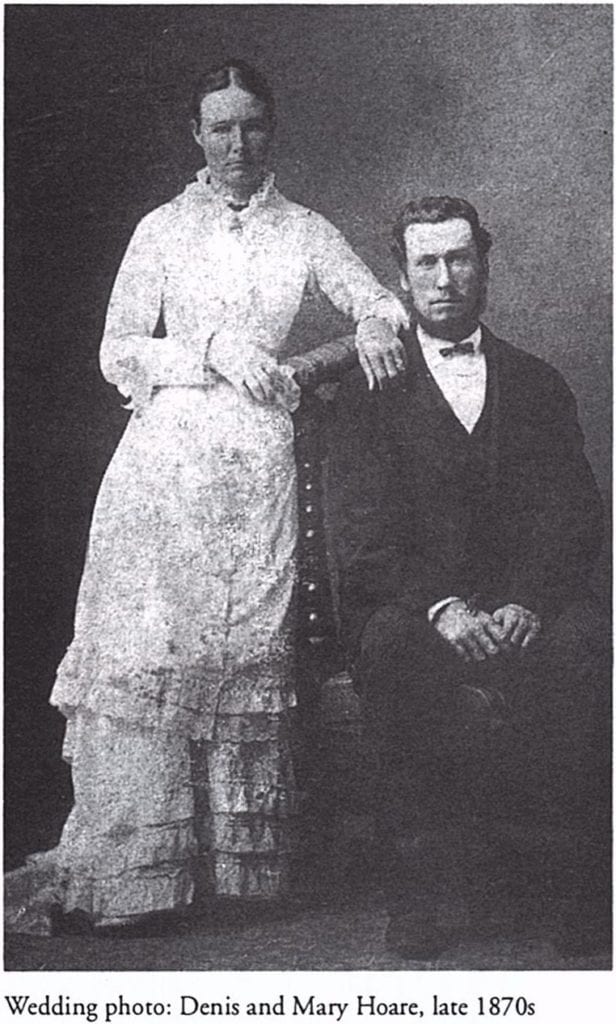Who was Denis Hoare?
Denis was born in 1851 at Dun-drum, County Tipperary, Ireland, and came out to Victoria when he was two years of age. He spent most of his early life on his father’s farm in Victoria. He came to Queens-land about the time of the Wills’ massacre at Cullin-la-Ringo (at that period one of the outposts of civilisation) in the Springsure district. At one point, he brought up a stud stallion for Wills, who was a neighbor of his father’s in Victoria. Denny (as he was known) used to drive the station teams at Cullin-la-Ringo, and made trips to Clermont, where he met Mary, eldest daughter of Mr. and Mrs. D. Sammon, who were dairying in the Clermont district. Dennis and Mary subsequently married in the late 1870s.

While at Cullin-la-Ringo he purchased a few good horses, gradually acquiring more. When Pine Hill opened, he had two splendid horse teams with which he made long trips into the interior. Denny lived through the Dawson floods in the early 70s, and had his share of losses.
Mr. Hoare was a Unionist, one of the heads of the Western Carriers’ Union at Pine Hill, of which Mr. Arthur Parnell was secretary.
Eventually, the family settled in Barcaldine before the township was really formed. At this time there was a family of four, eventually to become 10. Mary Hoare had persuaded Denis to buy a little house in Barcaldine, at that time a small settlement clustered around a railhead. His daughter Nora (Mrs. E. Coleman) was the first child born in Barcaldine after the railway station was opened on the 8th November, 1886. His third child, Margaret, was born 22 January 1883 under a wagon at Bogantungan, a staging post along Denny’s carting route.
Denny then had two teams of Clydesdale horses, eight or ten horses for each wagon. Loaded with up to 20 tonnes of wool, they were faster and won more of the work than the cumbersome bullock teams favoured by other carriers. A return journey from one woolshed could be over 1,000 miles, coaxing obstinate animals along rutted dusty tracks which became impassable quagmires after rain. Like other carriers, Denny would be away from any town for months at a time, so he took his family with him.
After they settled into town, Denny still travelled the roads, accompanied by a ‘spare boy’ and brought the wool in form stations such as Bowen Downs, Terrick Terrick, Oondooroo, Vindex and Barcaldine Downs.
In 1891, Australia’s colonial government put down the great shearer’s strike in Queensland. From the prominent part he took in the Union Denis got into bad odor and had some difficulty in securing loading after the strike was broken up.
The conflict compelled the radical socialist William Lane to start a utopia where all men would be equal. “New Australia” would be founded in Paraguay, which had been devastated by the Triple Alliance War and was desperate to repopulate.
Subsequently Denny became infatuated with Lane’s New Australia scheme, and resolved to join up with it. He disposed of his two teams and threw the proceeds into the common fund. His friends urged him to keep one team, but Denny said he had to be consistent, and he was on the same footing as the others.
In December 1893, Lane, his family and about 500 other unionists set sail on the Royal Tar for the 187,000-hectare collective in South America. But the scheme soon fell apart.
There was conflict amongst the settlers from the beginning when the first contingent of settlers arrived in Paraguay. There was dissent over prohibition of alcohol, relations with the locals and Lane’s leadership.
“I can’t help feeling that the movement cannot result in success if that incompetent man Lane continues to mismanage so utterly as he has done up to the present,” wrote colonist Tom Westwood.
Problems intensified after the second group of colonists – including the Hoare family – arrived in 1894. Dissention caused a rift in the colony and in May 1894, Lane and 58 others left New Australia to found Cosme, a new colony 72 kilometres farther south. Eventually New Australia was dissolved as a cooperative by the government of Paraguay.
Some settlers took up the option of taking up their own piece of land gifted by the Paraguan government, some founded communes elsewhere in Paraguay, others went home to Australia or on to England. Some descendants of the unionist colonists still live in Paraguay.
When the Paraguayan government eventually dissolved the failed collective, the British Government agreed to repatriate the survivors back to Queensland via London. Even today there are descendants of those unionists still in Paraguay.
Denny, in relating his experiences in Paraguay, used to say he and the family would have gone back to Ireland had they the means, but they were absolutely without funds. The family returned to Barcaldine in 1897, and Denny took on laboring work, and for a while had charge of the Council baths. He had a family of six sons and four daughters.
The eldest son, William, died when he was very young, as did also another son, Pat. William (named after the first boy) was accidentally killed at Isisford before Denny’s death. John died of wounds received in action at Bure, near Dernancourt, in France, on the 7th April, 1918, after gaining a Military Medal at Messines in 1917. He was a member of the 52nd Battalion. He was with E. Hukins, Vic. Leyland, P. Rasmussen, and other Barcaldine “boys” at the time.
Dennis Hoare was one of the foundation members of St. Francis’ Branch, H.A.C.B.S., but after his return from Paraguay never re-joined.
